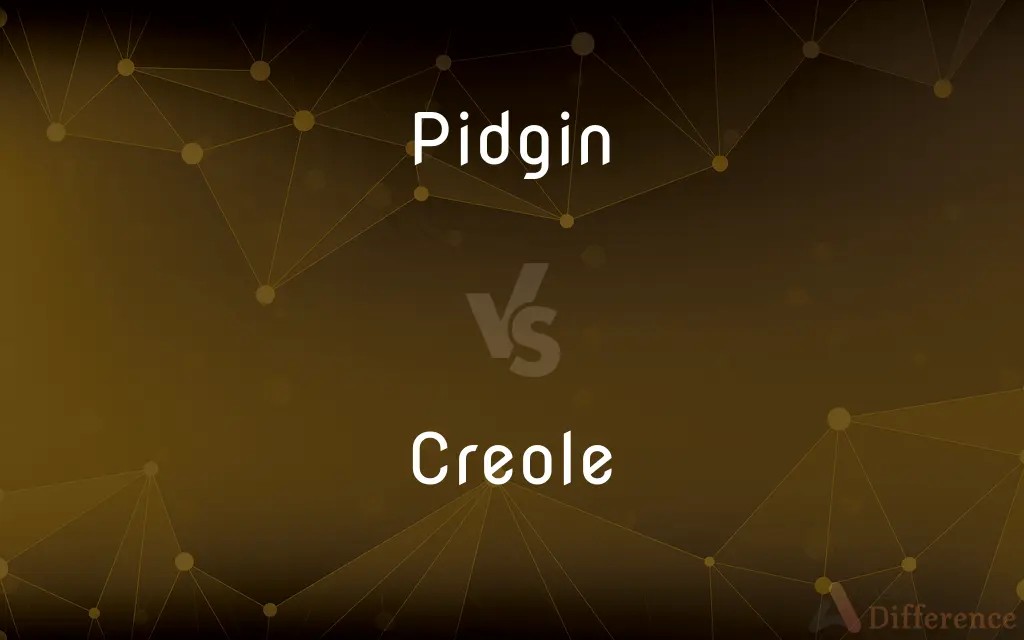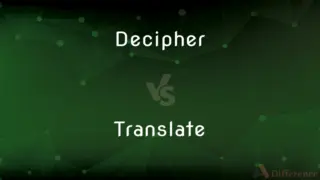Pidgin vs. Creole — What's the Difference?
Edited by Tayyaba Rehman — By Fiza Rafique — Updated on April 3, 2024
Pidgin is simplified language that develops as a means of communication between speakers of different languages. Creole is stable, fully developed language that was originally pidgin but has become nativized, being learned as a first language by children.

Difference Between Pidgin and Creole
Table of Contents
ADVERTISEMENT
Key Differences
Pidgin languages emerge when speakers of distinct languages need to communicate, typically for trade or work, without learning the other's native language thoroughly. Pidgins are characterized by limited vocabulary, simplified grammar, and are not native to any population. Whereas Creoles evolve when a pidgin, developed from one or more languages, becomes the first language of a community. Over time, Creoles expand in complexity, acquiring a stable grammatical structure and richer vocabulary.
While pidgins are auxiliary languages, arising out of necessity and used alongside native languages, they lack depth in cultural and expressive capacity due to their simplified nature and limited vocabulary. On the other hand, Creoles, as fully developed languages, embody the culture, identity, and community of their speakers, often with a depth and expressiveness comparable to any other native language.
Pidgin languages often have no native speakers; they are learned as second languages for specific purposes. This transient nature means they can change quickly or disappear as the conditions that produced them change. Conversely, Creole languages have native speakers, typically the children of pidgin speakers, which lends them stability and leads to their evolution into more complex language systems.
The development of a pidgin into a Creole is a process known as creolization, which involves the expansion of a pidgin's vocabulary and the development of a more complex grammar and syntax. This process usually occurs over generations, as the pidgin becomes the first language of a community and adapts to fulfill all the communicative needs of its speakers. Creoles, therefore, are a testament to linguistic evolution and cultural amalgamation.
Despite their origins from pidgins, Creoles are not simply pidgins that have become more complex. They are influenced by the languages of all contributing communities, including those of the original pidgin speakers and, often, other languages that have interacted with the community since the pidgin's inception. This results in Creoles having unique linguistic features that are not found in any of their source languages.
ADVERTISEMENT
Comparison Chart
Definition
A simplified, auxiliary language developed for communication between speakers of different languages.
A stable, fully developed language that originated from a pidgin.
Nativity
No native speakers; used as a second language.
Has native speakers, often learned as a first language by children.
Complexity
Limited vocabulary and simplified grammar.
More complex grammar and expanded vocabulary.
Stability and Evolution
Transient and may change or disappear quickly.
Stable and evolves over generations into a more complex language system.
Cultural Depth
Lacks depth in cultural and expressive capacity.
Embodies the culture, identity, and community of its speakers.
Compare with Definitions
Pidgin
A bridge language created to facilitate communication between speakers of different languages, with simplified grammar and limited vocabulary.
In trading ports, a pidgin language often emerges to allow merchants to conduct business.
Creole
A language that began as a pidgin but has developed into a full, stable language with native speakers.
The Creole language is spoken at home and is the first language of many children in the community.
Pidgin
Characterized by its simplicity and practicality for specific communication needs.
The pidgin had a mix of vocabulary from several languages but very simplified grammar.
Creole
Serves as the primary means of communication for its speakers, capable of expressing complex and nuanced ideas.
Literature and poetry in Creole vividly express the culture's identity and emotions.
Pidgin
Can evolve into a Creole when it becomes the native language of a community.
Over generations, the pidgin spoken in the region began to develop into a Creole.
Creole
Has a rich vocabulary and complex grammar, reflective of its evolution from a pidgin.
Unlike its pidgin origins, the Creole language has complex verb tenses and a wide range of expressions.
Pidgin
Primarily used in trade, work, or situations requiring basic communication across language barriers.
Workers from various linguistic backgrounds used a pidgin to coordinate the construction project.
Creole
Results from the nativization of a pidgin, gaining complexity and stability over generations.
The Creole language has evolved to include terms for modern concepts, integrating technological vocabulary.
Pidgin
Considered auxiliary, without native speakers and often with a fluctuating structure.
As a pidgin, it lacked formal structure, serving more as a practical tool than a cultural language.
Creole
Recognized as a legitimate language, often embodying the identity and culture of its speakers.
The government officially recognized Creole as a national language, affirming its importance in the community's heritage.
Pidgin
A pidgin , or pidgin language, is a grammatically simplified means of communication that develops between two or more groups that do not have a language in common: typically, its vocabulary and grammar are limited and often drawn from several languages. It is most commonly employed in situations such as trade, or where both groups speak languages different from the language of the country in which they reside (but where there is no common language between the groups).
Creole
A person of mixed European and black descent, especially in the Caribbean.
Pidgin
A grammatically simplified form of a language, typically English, Dutch, or Portuguese, some elements of which are taken from local languages, used for communication between people not sharing a common language.
Creole
A mother tongue formed from the contact of a European language (especially English, French, Spanish, or Portuguese) with local languages (especially African languages spoken by slaves in the West Indies)
A Portuguese-based Creole
Pidgin
A simplified form of speech that is usually a mixture of two or more languages, has a rudimentary grammar and vocabulary, is used for communication between groups speaking different languages, and is not spoken as a first or native language. Also called contact language.
Creole
Relating to a Creole or Creoles
Research on pidgin and Creole languages
A restaurant serving both international and Creole cuisine
Pidgin
(linguistics) An amalgamation of two disparate languages, used by two populations having no common language as a lingua franca to communicate with each other, lacking formalized grammar and having a small, utilitarian vocabulary and no native speakers.
Creole
A person of European ancestry born in the West Indies or Spanish America.
Pidgin
A person's business, occupation, work, or trade (also spelt as pigeon)
Creole
A person descended from or culturally related to the original French settlers of the southern United States, especially Louisiana.
Pidgin
An artificial language used for trade between speakers of different languages
Creole
The French dialect spoken by these people.
Creole
A person descended from or culturally related to the Spanish and Portuguese settlers of the Gulf States.
Creole
Often creole A person of mixed African and European ancestry who speaks a creolized language, especially one based on French or Spanish.
Creole
A black slave born in the Americas as opposed to one brought from Africa.
Creole
Creole A creolized language.
Creole
Haitian Creole.
Creole
Of, relating to, or characteristic of the Creoles.
Creole
Creole Cooked with a spicy sauce containing tomatoes, onions, and peppers
Shrimp creole.
Creole cuisine.
Creole
(linguistics) A language formed from two or more languages which has developed from a pidgin to become a first language.
Creole
A style of hoop earrings that comprise of a hoop that has an inconsistent thickness and/or is elongated in shape
Creole
One born of European parents in the American colonies of France or Spain or in the States which were once such colonies, esp. a person of French or Spanish descent, who is a native inhabitant of Louisiana, or one of the States adjoining, bordering on the Gulf of of Mexico.
Creole
Of or pertaining to a Creole or the Creoles.
Creole
A person of European descent born in the West Indies or Latin America
Creole
A person descended from French ancestors in southern United States (especially Louisiana)
Creole
A mother tongue that originates from contact between two languages
Creole
Of or relating to a language that arises from contact between two other languages and has features of both;
Creole grammars
Creole
Of or relating to or characteristic of native-born persons of French descent in Louisiana;
Creole cooking
Common Curiosities
How does a pidgin become a Creole?
A pidgin becomes a Creole through a process called creolization, where it evolves into a fully developed language with native speakers, typically over generations.
What is a Creole language?
A Creole is a stable language that originated from a pidgin but has evolved and is learned as a first language by children in a community.
Do Creoles have their own culture?
Yes, Creoles often embody the culture, identity, and community of their speakers, reflecting a unique blend of influences from the contributing languages.
Are pidgins and Creoles simplified versions of other languages?
Pidgins are simplified for practical communication needs, while Creoles, though originating from pidgins, develop into complex languages in their own right.
What is a pidgin language?
A pidgin is a simplified language that emerges to facilitate communication between speakers of different native languages, without becoming the mother tongue of any community.
Can any pidgin develop into a Creole?
Theoretically, yes, but it requires a community to adopt the pidgin as their primary language across generations, leading to its evolution and stabilization.
What linguistic features distinguish a Creole from its pidgin origin?
Creoles have a more complex grammar and richer vocabulary than their pidgin origins, reflecting their evolution and stabilization as native languages.
Is creolization a quick process?
Creolization is typically a gradual process, occurring over generations as a pidgin language becomes fully integrated and expanded within a community.
Can someone be a native speaker of a Creole?
Yes, individuals can and do grow up speaking a Creole as their first language, especially in communities where it has become fully nativized.
Can pidgins and Creoles coexist in the same community?
Yes, it's possible for both a pidgin and its derived Creole to coexist, especially during the transitional phase of creolization.
How are new Creoles formed?
New Creoles form when pidgins, developed for communication between speakers of different languages, become the native language of a community.
What makes a language a pidgin?
A language is considered a pidgin when it is used as an auxiliary language between speakers of different native languages, characterized by simplified grammar and limited vocabulary.
How does bilingualism affect Creole languages?
Bilingualism can influence Creole languages by introducing new vocabulary and grammatical structures, potentially leading to further linguistic evolution.
Are there any regions where Creoles are the dominant language?
Yes, there are regions, especially in the Caribbean and parts of Africa, where Creoles are the dominant, if not the official, languages.
How are pidgins and Creoles studied and classified by linguists?
Linguists study pidgins and Creoles as part of sociolinguistics and creole studies, focusing on their origins, structure, evolution, and role in society.
Share Your Discovery

Previous Comparison
See vs. View
Next Comparison
Decipher vs. TranslateAuthor Spotlight
Written by
Fiza RafiqueFiza Rafique is a skilled content writer at AskDifference.com, where she meticulously refines and enhances written pieces. Drawing from her vast editorial expertise, Fiza ensures clarity, accuracy, and precision in every article. Passionate about language, she continually seeks to elevate the quality of content for readers worldwide.
Edited by
Tayyaba RehmanTayyaba Rehman is a distinguished writer, currently serving as a primary contributor to askdifference.com. As a researcher in semantics and etymology, Tayyaba's passion for the complexity of languages and their distinctions has found a perfect home on the platform. Tayyaba delves into the intricacies of language, distinguishing between commonly confused words and phrases, thereby providing clarity for readers worldwide.















































